Tesco's Strategic Management: Goals, Structure, and Internal Analysis
VerifiedAdded on 2020/01/15
|8
|2188
|337
Report
AI Summary
This report provides a comprehensive analysis of Tesco's strategic management, focusing on its corporate goals and objectives, organizational structure, and the four functions of management (planning, organizing, leading, and controlling). It examines Tesco's divisional organizational culture and its impact on communication. The report also explores the importance of internal analysis within the strategic management process, detailing the steps involved in establishing vision, analyzing opportunities and threats, assessing strengths and weaknesses, and implementing strategies. Furthermore, it discusses ways to create innovative organizational cultures, such as fostering a flexible working environment, celebrating milestones, and employing participative leadership. The benefits of effective communication within Tesco, including its role in diversity, team building, employee morale, and increased productivity, are also highlighted. The report concludes by emphasizing the crucial role of strategic management in enhancing Tesco's operations and the significance of promoting an innovative culture and effective communication.

MFRD
Paraphrase This Document
Need a fresh take? Get an instant paraphrase of this document with our AI Paraphraser
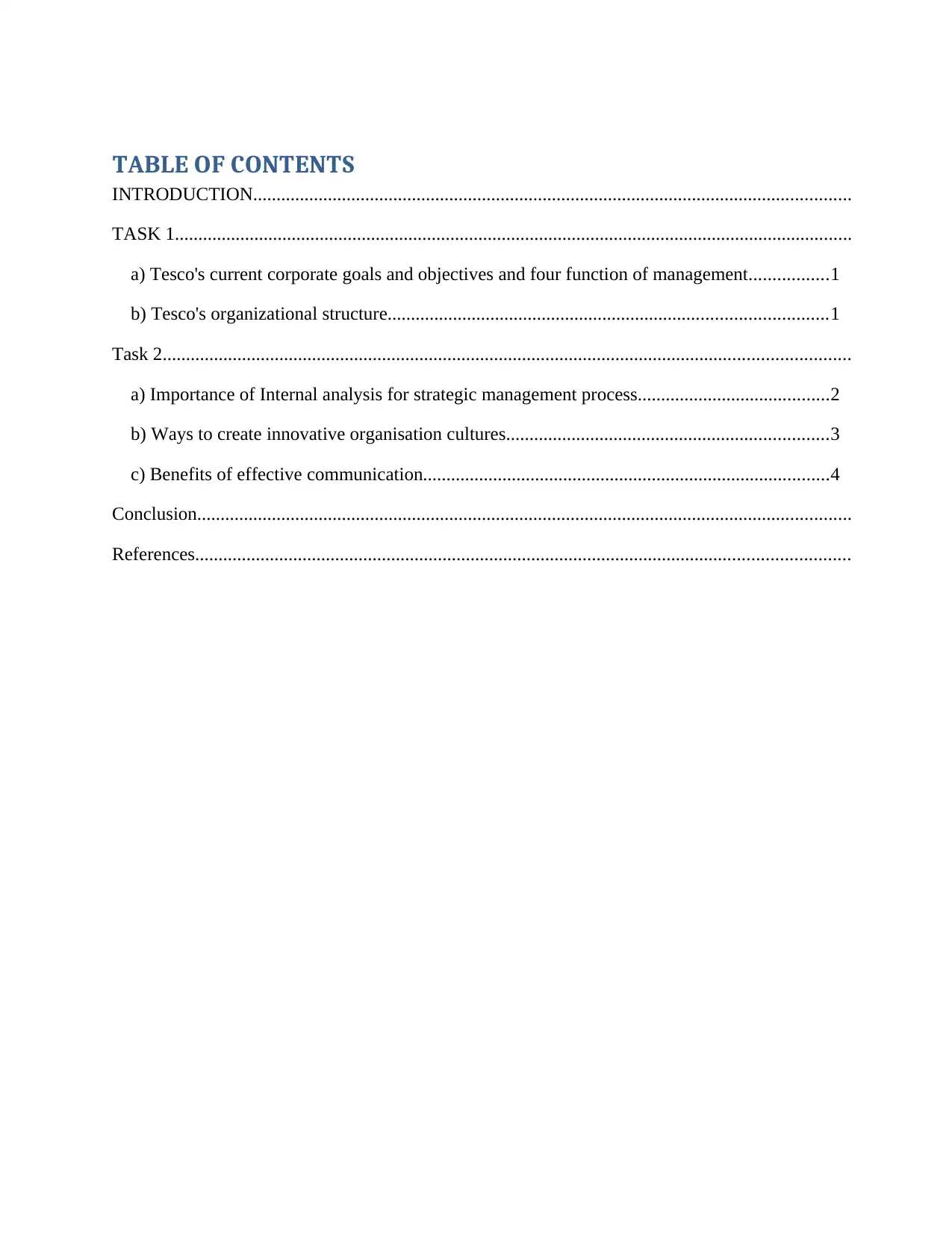
TABLE OF CONTENTS
INTRODUCTION................................................................................................................................
TASK 1.................................................................................................................................................
a) Tesco's current corporate goals and objectives and four function of management.................1
b) Tesco's organizational structure..............................................................................................1
Task 2...................................................................................................................................................
a) Importance of Internal analysis for strategic management process.........................................2
b) Ways to create innovative organisation cultures.....................................................................3
c) Benefits of effective communication.......................................................................................4
Conclusion............................................................................................................................................
References............................................................................................................................................
INTRODUCTION................................................................................................................................
TASK 1.................................................................................................................................................
a) Tesco's current corporate goals and objectives and four function of management.................1
b) Tesco's organizational structure..............................................................................................1
Task 2...................................................................................................................................................
a) Importance of Internal analysis for strategic management process.........................................2
b) Ways to create innovative organisation cultures.....................................................................3
c) Benefits of effective communication.......................................................................................4
Conclusion............................................................................................................................................
References............................................................................................................................................
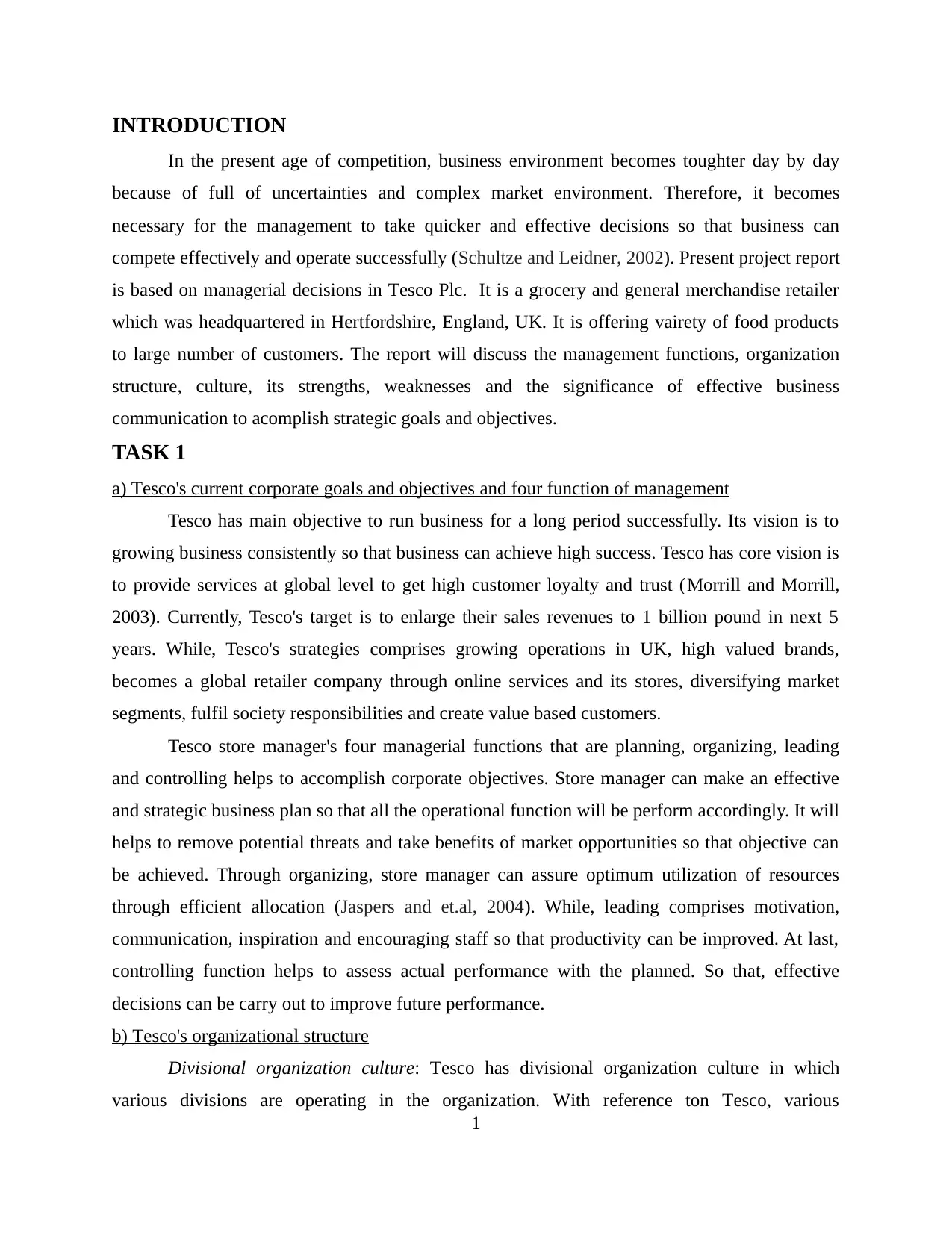
INTRODUCTION
In the present age of competition, business environment becomes toughter day by day
because of full of uncertainties and complex market environment. Therefore, it becomes
necessary for the management to take quicker and effective decisions so that business can
compete effectively and operate successfully (Schultze and Leidner, 2002). Present project report
is based on managerial decisions in Tesco Plc. It is a grocery and general merchandise retailer
which was headquartered in Hertfordshire, England, UK. It is offering vairety of food products
to large number of customers. The report will discuss the management functions, organization
structure, culture, its strengths, weaknesses and the significance of effective business
communication to acomplish strategic goals and objectives.
TASK 1
a) Tesco's current corporate goals and objectives and four function of management
Tesco has main objective to run business for a long period successfully. Its vision is to
growing business consistently so that business can achieve high success. Tesco has core vision is
to provide services at global level to get high customer loyalty and trust (Morrill and Morrill,
2003). Currently, Tesco's target is to enlarge their sales revenues to 1 billion pound in next 5
years. While, Tesco's strategies comprises growing operations in UK, high valued brands,
becomes a global retailer company through online services and its stores, diversifying market
segments, fulfil society responsibilities and create value based customers.
Tesco store manager's four managerial functions that are planning, organizing, leading
and controlling helps to accomplish corporate objectives. Store manager can make an effective
and strategic business plan so that all the operational function will be perform accordingly. It will
helps to remove potential threats and take benefits of market opportunities so that objective can
be achieved. Through organizing, store manager can assure optimum utilization of resources
through efficient allocation (Jaspers and et.al, 2004). While, leading comprises motivation,
communication, inspiration and encouraging staff so that productivity can be improved. At last,
controlling function helps to assess actual performance with the planned. So that, effective
decisions can be carry out to improve future performance.
b) Tesco's organizational structure
Divisional organization culture: Tesco has divisional organization culture in which
various divisions are operating in the organization. With reference ton Tesco, various
1
In the present age of competition, business environment becomes toughter day by day
because of full of uncertainties and complex market environment. Therefore, it becomes
necessary for the management to take quicker and effective decisions so that business can
compete effectively and operate successfully (Schultze and Leidner, 2002). Present project report
is based on managerial decisions in Tesco Plc. It is a grocery and general merchandise retailer
which was headquartered in Hertfordshire, England, UK. It is offering vairety of food products
to large number of customers. The report will discuss the management functions, organization
structure, culture, its strengths, weaknesses and the significance of effective business
communication to acomplish strategic goals and objectives.
TASK 1
a) Tesco's current corporate goals and objectives and four function of management
Tesco has main objective to run business for a long period successfully. Its vision is to
growing business consistently so that business can achieve high success. Tesco has core vision is
to provide services at global level to get high customer loyalty and trust (Morrill and Morrill,
2003). Currently, Tesco's target is to enlarge their sales revenues to 1 billion pound in next 5
years. While, Tesco's strategies comprises growing operations in UK, high valued brands,
becomes a global retailer company through online services and its stores, diversifying market
segments, fulfil society responsibilities and create value based customers.
Tesco store manager's four managerial functions that are planning, organizing, leading
and controlling helps to accomplish corporate objectives. Store manager can make an effective
and strategic business plan so that all the operational function will be perform accordingly. It will
helps to remove potential threats and take benefits of market opportunities so that objective can
be achieved. Through organizing, store manager can assure optimum utilization of resources
through efficient allocation (Jaspers and et.al, 2004). While, leading comprises motivation,
communication, inspiration and encouraging staff so that productivity can be improved. At last,
controlling function helps to assess actual performance with the planned. So that, effective
decisions can be carry out to improve future performance.
b) Tesco's organizational structure
Divisional organization culture: Tesco has divisional organization culture in which
various divisions are operating in the organization. With reference ton Tesco, various
1
⊘ This is a preview!⊘
Do you want full access?
Subscribe today to unlock all pages.

Trusted by 1+ million students worldwide
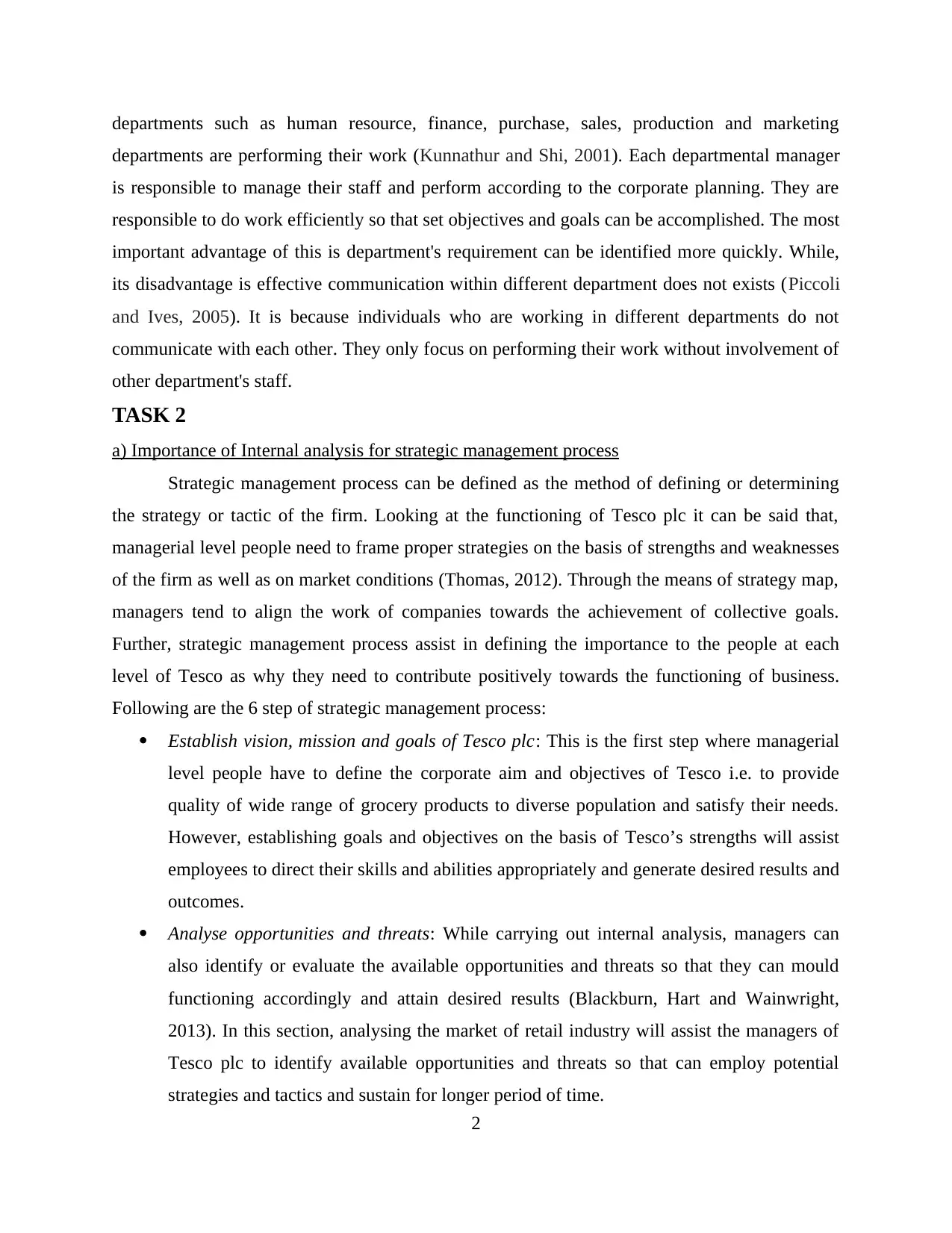
departments such as human resource, finance, purchase, sales, production and marketing
departments are performing their work (Kunnathur and Shi, 2001). Each departmental manager
is responsible to manage their staff and perform according to the corporate planning. They are
responsible to do work efficiently so that set objectives and goals can be accomplished. The most
important advantage of this is department's requirement can be identified more quickly. While,
its disadvantage is effective communication within different department does not exists (Piccoli
and Ives, 2005). It is because individuals who are working in different departments do not
communicate with each other. They only focus on performing their work without involvement of
other department's staff.
TASK 2
a) Importance of Internal analysis for strategic management process
Strategic management process can be defined as the method of defining or determining
the strategy or tactic of the firm. Looking at the functioning of Tesco plc it can be said that,
managerial level people need to frame proper strategies on the basis of strengths and weaknesses
of the firm as well as on market conditions (Thomas, 2012). Through the means of strategy map,
managers tend to align the work of companies towards the achievement of collective goals.
Further, strategic management process assist in defining the importance to the people at each
level of Tesco as why they need to contribute positively towards the functioning of business.
Following are the 6 step of strategic management process:
Establish vision, mission and goals of Tesco plc: This is the first step where managerial
level people have to define the corporate aim and objectives of Tesco i.e. to provide
quality of wide range of grocery products to diverse population and satisfy their needs.
However, establishing goals and objectives on the basis of Tesco’s strengths will assist
employees to direct their skills and abilities appropriately and generate desired results and
outcomes.
Analyse opportunities and threats: While carrying out internal analysis, managers can
also identify or evaluate the available opportunities and threats so that they can mould
functioning accordingly and attain desired results (Blackburn, Hart and Wainwright,
2013). In this section, analysing the market of retail industry will assist the managers of
Tesco plc to identify available opportunities and threats so that can employ potential
strategies and tactics and sustain for longer period of time.
2
departments are performing their work (Kunnathur and Shi, 2001). Each departmental manager
is responsible to manage their staff and perform according to the corporate planning. They are
responsible to do work efficiently so that set objectives and goals can be accomplished. The most
important advantage of this is department's requirement can be identified more quickly. While,
its disadvantage is effective communication within different department does not exists (Piccoli
and Ives, 2005). It is because individuals who are working in different departments do not
communicate with each other. They only focus on performing their work without involvement of
other department's staff.
TASK 2
a) Importance of Internal analysis for strategic management process
Strategic management process can be defined as the method of defining or determining
the strategy or tactic of the firm. Looking at the functioning of Tesco plc it can be said that,
managerial level people need to frame proper strategies on the basis of strengths and weaknesses
of the firm as well as on market conditions (Thomas, 2012). Through the means of strategy map,
managers tend to align the work of companies towards the achievement of collective goals.
Further, strategic management process assist in defining the importance to the people at each
level of Tesco as why they need to contribute positively towards the functioning of business.
Following are the 6 step of strategic management process:
Establish vision, mission and goals of Tesco plc: This is the first step where managerial
level people have to define the corporate aim and objectives of Tesco i.e. to provide
quality of wide range of grocery products to diverse population and satisfy their needs.
However, establishing goals and objectives on the basis of Tesco’s strengths will assist
employees to direct their skills and abilities appropriately and generate desired results and
outcomes.
Analyse opportunities and threats: While carrying out internal analysis, managers can
also identify or evaluate the available opportunities and threats so that they can mould
functioning accordingly and attain desired results (Blackburn, Hart and Wainwright,
2013). In this section, analysing the market of retail industry will assist the managers of
Tesco plc to identify available opportunities and threats so that can employ potential
strategies and tactics and sustain for longer period of time.
2
Paraphrase This Document
Need a fresh take? Get an instant paraphrase of this document with our AI Paraphraser
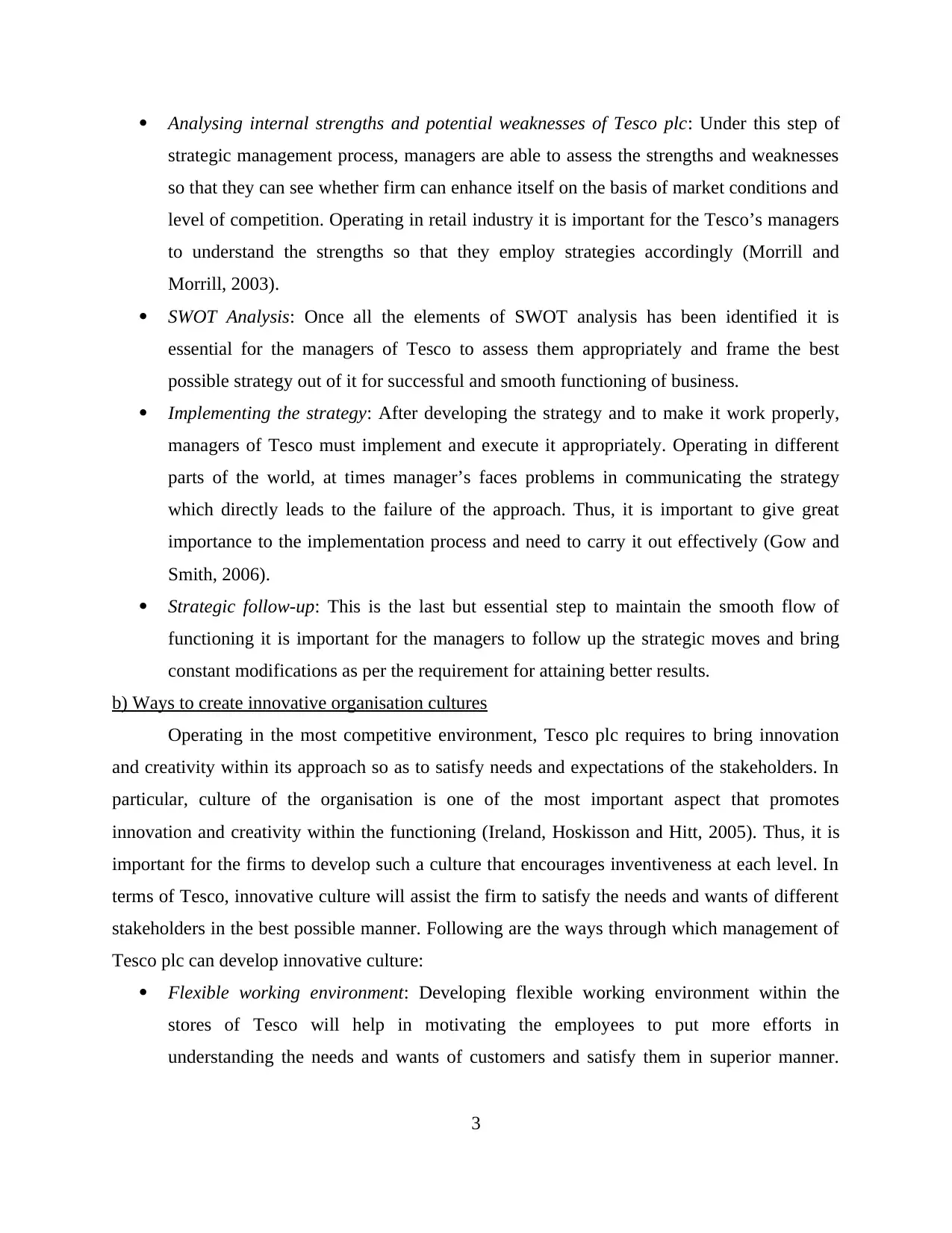
Analysing internal strengths and potential weaknesses of Tesco plc: Under this step of
strategic management process, managers are able to assess the strengths and weaknesses
so that they can see whether firm can enhance itself on the basis of market conditions and
level of competition. Operating in retail industry it is important for the Tesco’s managers
to understand the strengths so that they employ strategies accordingly (Morrill and
Morrill, 2003).
SWOT Analysis: Once all the elements of SWOT analysis has been identified it is
essential for the managers of Tesco to assess them appropriately and frame the best
possible strategy out of it for successful and smooth functioning of business.
Implementing the strategy: After developing the strategy and to make it work properly,
managers of Tesco must implement and execute it appropriately. Operating in different
parts of the world, at times manager’s faces problems in communicating the strategy
which directly leads to the failure of the approach. Thus, it is important to give great
importance to the implementation process and need to carry it out effectively (Gow and
Smith, 2006).
Strategic follow-up: This is the last but essential step to maintain the smooth flow of
functioning it is important for the managers to follow up the strategic moves and bring
constant modifications as per the requirement for attaining better results.
b) Ways to create innovative organisation cultures
Operating in the most competitive environment, Tesco plc requires to bring innovation
and creativity within its approach so as to satisfy needs and expectations of the stakeholders. In
particular, culture of the organisation is one of the most important aspect that promotes
innovation and creativity within the functioning (Ireland, Hoskisson and Hitt, 2005). Thus, it is
important for the firms to develop such a culture that encourages inventiveness at each level. In
terms of Tesco, innovative culture will assist the firm to satisfy the needs and wants of different
stakeholders in the best possible manner. Following are the ways through which management of
Tesco plc can develop innovative culture:
Flexible working environment: Developing flexible working environment within the
stores of Tesco will help in motivating the employees to put more efforts in
understanding the needs and wants of customers and satisfy them in superior manner.
3
strategic management process, managers are able to assess the strengths and weaknesses
so that they can see whether firm can enhance itself on the basis of market conditions and
level of competition. Operating in retail industry it is important for the Tesco’s managers
to understand the strengths so that they employ strategies accordingly (Morrill and
Morrill, 2003).
SWOT Analysis: Once all the elements of SWOT analysis has been identified it is
essential for the managers of Tesco to assess them appropriately and frame the best
possible strategy out of it for successful and smooth functioning of business.
Implementing the strategy: After developing the strategy and to make it work properly,
managers of Tesco must implement and execute it appropriately. Operating in different
parts of the world, at times manager’s faces problems in communicating the strategy
which directly leads to the failure of the approach. Thus, it is important to give great
importance to the implementation process and need to carry it out effectively (Gow and
Smith, 2006).
Strategic follow-up: This is the last but essential step to maintain the smooth flow of
functioning it is important for the managers to follow up the strategic moves and bring
constant modifications as per the requirement for attaining better results.
b) Ways to create innovative organisation cultures
Operating in the most competitive environment, Tesco plc requires to bring innovation
and creativity within its approach so as to satisfy needs and expectations of the stakeholders. In
particular, culture of the organisation is one of the most important aspect that promotes
innovation and creativity within the functioning (Ireland, Hoskisson and Hitt, 2005). Thus, it is
important for the firms to develop such a culture that encourages inventiveness at each level. In
terms of Tesco, innovative culture will assist the firm to satisfy the needs and wants of different
stakeholders in the best possible manner. Following are the ways through which management of
Tesco plc can develop innovative culture:
Flexible working environment: Developing flexible working environment within the
stores of Tesco will help in motivating the employees to put more efforts in
understanding the needs and wants of customers and satisfy them in superior manner.
3
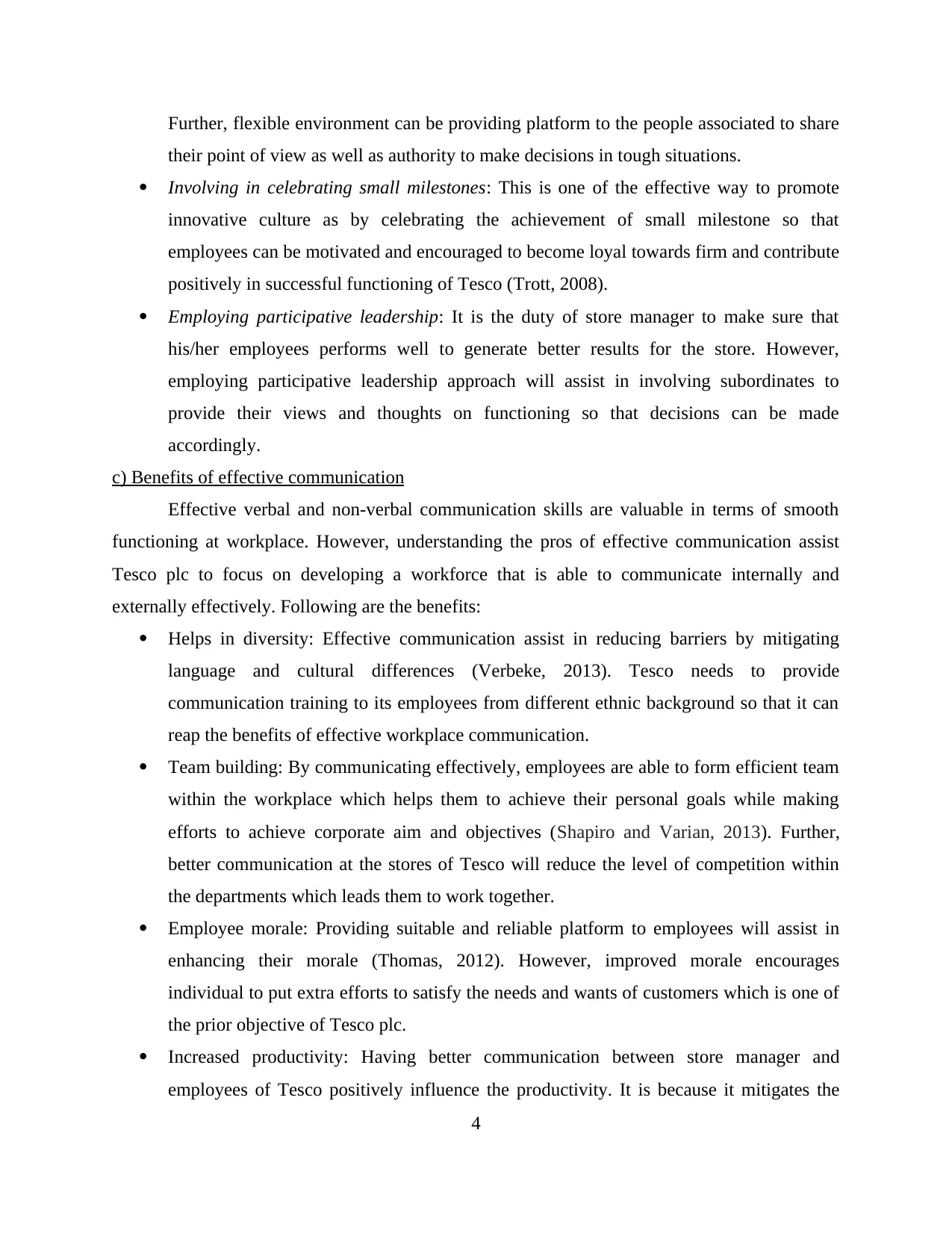
Further, flexible environment can be providing platform to the people associated to share
their point of view as well as authority to make decisions in tough situations.
Involving in celebrating small milestones: This is one of the effective way to promote
innovative culture as by celebrating the achievement of small milestone so that
employees can be motivated and encouraged to become loyal towards firm and contribute
positively in successful functioning of Tesco (Trott, 2008).
Employing participative leadership: It is the duty of store manager to make sure that
his/her employees performs well to generate better results for the store. However,
employing participative leadership approach will assist in involving subordinates to
provide their views and thoughts on functioning so that decisions can be made
accordingly.
c) Benefits of effective communication
Effective verbal and non-verbal communication skills are valuable in terms of smooth
functioning at workplace. However, understanding the pros of effective communication assist
Tesco plc to focus on developing a workforce that is able to communicate internally and
externally effectively. Following are the benefits:
Helps in diversity: Effective communication assist in reducing barriers by mitigating
language and cultural differences (Verbeke, 2013). Tesco needs to provide
communication training to its employees from different ethnic background so that it can
reap the benefits of effective workplace communication.
Team building: By communicating effectively, employees are able to form efficient team
within the workplace which helps them to achieve their personal goals while making
efforts to achieve corporate aim and objectives (Shapiro and Varian, 2013). Further,
better communication at the stores of Tesco will reduce the level of competition within
the departments which leads them to work together.
Employee morale: Providing suitable and reliable platform to employees will assist in
enhancing their morale (Thomas, 2012). However, improved morale encourages
individual to put extra efforts to satisfy the needs and wants of customers which is one of
the prior objective of Tesco plc.
Increased productivity: Having better communication between store manager and
employees of Tesco positively influence the productivity. It is because it mitigates the
4
their point of view as well as authority to make decisions in tough situations.
Involving in celebrating small milestones: This is one of the effective way to promote
innovative culture as by celebrating the achievement of small milestone so that
employees can be motivated and encouraged to become loyal towards firm and contribute
positively in successful functioning of Tesco (Trott, 2008).
Employing participative leadership: It is the duty of store manager to make sure that
his/her employees performs well to generate better results for the store. However,
employing participative leadership approach will assist in involving subordinates to
provide their views and thoughts on functioning so that decisions can be made
accordingly.
c) Benefits of effective communication
Effective verbal and non-verbal communication skills are valuable in terms of smooth
functioning at workplace. However, understanding the pros of effective communication assist
Tesco plc to focus on developing a workforce that is able to communicate internally and
externally effectively. Following are the benefits:
Helps in diversity: Effective communication assist in reducing barriers by mitigating
language and cultural differences (Verbeke, 2013). Tesco needs to provide
communication training to its employees from different ethnic background so that it can
reap the benefits of effective workplace communication.
Team building: By communicating effectively, employees are able to form efficient team
within the workplace which helps them to achieve their personal goals while making
efforts to achieve corporate aim and objectives (Shapiro and Varian, 2013). Further,
better communication at the stores of Tesco will reduce the level of competition within
the departments which leads them to work together.
Employee morale: Providing suitable and reliable platform to employees will assist in
enhancing their morale (Thomas, 2012). However, improved morale encourages
individual to put extra efforts to satisfy the needs and wants of customers which is one of
the prior objective of Tesco plc.
Increased productivity: Having better communication between store manager and
employees of Tesco positively influence the productivity. It is because it mitigates the
4
⊘ This is a preview!⊘
Do you want full access?
Subscribe today to unlock all pages.

Trusted by 1+ million students worldwide
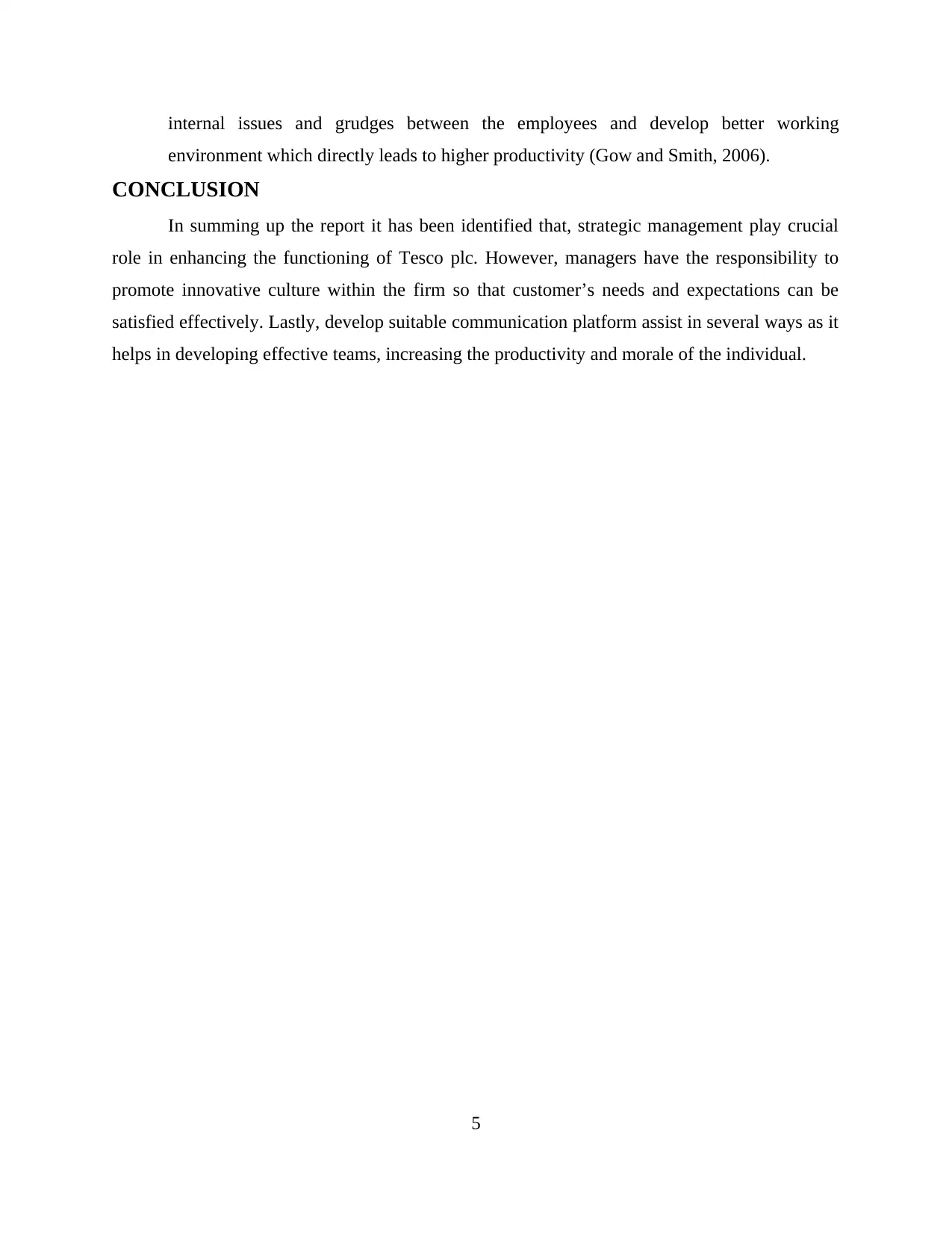
internal issues and grudges between the employees and develop better working
environment which directly leads to higher productivity (Gow and Smith, 2006).
CONCLUSION
In summing up the report it has been identified that, strategic management play crucial
role in enhancing the functioning of Tesco plc. However, managers have the responsibility to
promote innovative culture within the firm so that customer’s needs and expectations can be
satisfied effectively. Lastly, develop suitable communication platform assist in several ways as it
helps in developing effective teams, increasing the productivity and morale of the individual.
5
environment which directly leads to higher productivity (Gow and Smith, 2006).
CONCLUSION
In summing up the report it has been identified that, strategic management play crucial
role in enhancing the functioning of Tesco plc. However, managers have the responsibility to
promote innovative culture within the firm so that customer’s needs and expectations can be
satisfied effectively. Lastly, develop suitable communication platform assist in several ways as it
helps in developing effective teams, increasing the productivity and morale of the individual.
5
Paraphrase This Document
Need a fresh take? Get an instant paraphrase of this document with our AI Paraphraser
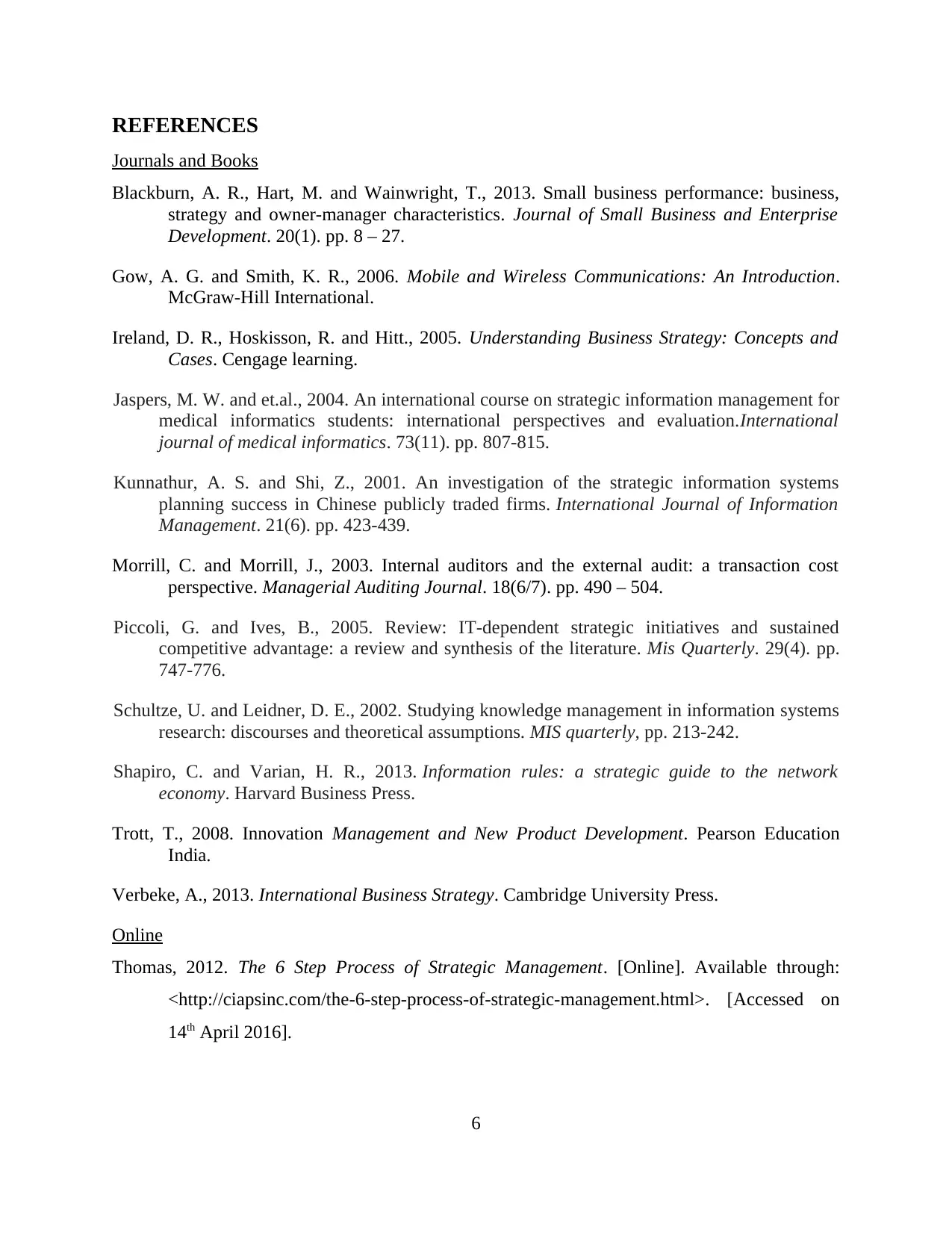
REFERENCES
Journals and Books
Blackburn, A. R., Hart, M. and Wainwright, T., 2013. Small business performance: business,
strategy and owner‐manager characteristics. Journal of Small Business and Enterprise
Development. 20(1). pp. 8 – 27.
Gow, A. G. and Smith, K. R., 2006. Mobile and Wireless Communications: An Introduction.
McGraw-Hill International.
Ireland, D. R., Hoskisson, R. and Hitt., 2005. Understanding Business Strategy: Concepts and
Cases. Cengage learning.
Jaspers, M. W. and et.al., 2004. An international course on strategic information management for
medical informatics students: international perspectives and evaluation.International
journal of medical informatics. 73(11). pp. 807-815.
Kunnathur, A. S. and Shi, Z., 2001. An investigation of the strategic information systems
planning success in Chinese publicly traded firms. International Journal of Information
Management. 21(6). pp. 423-439.
Morrill, C. and Morrill, J., 2003. Internal auditors and the external audit: a transaction cost
perspective. Managerial Auditing Journal. 18(6/7). pp. 490 – 504.
Piccoli, G. and Ives, B., 2005. Review: IT-dependent strategic initiatives and sustained
competitive advantage: a review and synthesis of the literature. Mis Quarterly. 29(4). pp.
747-776.
Schultze, U. and Leidner, D. E., 2002. Studying knowledge management in information systems
research: discourses and theoretical assumptions. MIS quarterly, pp. 213-242.
Shapiro, C. and Varian, H. R., 2013. Information rules: a strategic guide to the network
economy. Harvard Business Press.
Trott, T., 2008. Innovation Management and New Product Development. Pearson Education
India.
Verbeke, A., 2013. International Business Strategy. Cambridge University Press.
Online
Thomas, 2012. The 6 Step Process of Strategic Management. [Online]. Available through:
<http://ciapsinc.com/the-6-step-process-of-strategic-management.html>. [Accessed on
14th April 2016].
6
Journals and Books
Blackburn, A. R., Hart, M. and Wainwright, T., 2013. Small business performance: business,
strategy and owner‐manager characteristics. Journal of Small Business and Enterprise
Development. 20(1). pp. 8 – 27.
Gow, A. G. and Smith, K. R., 2006. Mobile and Wireless Communications: An Introduction.
McGraw-Hill International.
Ireland, D. R., Hoskisson, R. and Hitt., 2005. Understanding Business Strategy: Concepts and
Cases. Cengage learning.
Jaspers, M. W. and et.al., 2004. An international course on strategic information management for
medical informatics students: international perspectives and evaluation.International
journal of medical informatics. 73(11). pp. 807-815.
Kunnathur, A. S. and Shi, Z., 2001. An investigation of the strategic information systems
planning success in Chinese publicly traded firms. International Journal of Information
Management. 21(6). pp. 423-439.
Morrill, C. and Morrill, J., 2003. Internal auditors and the external audit: a transaction cost
perspective. Managerial Auditing Journal. 18(6/7). pp. 490 – 504.
Piccoli, G. and Ives, B., 2005. Review: IT-dependent strategic initiatives and sustained
competitive advantage: a review and synthesis of the literature. Mis Quarterly. 29(4). pp.
747-776.
Schultze, U. and Leidner, D. E., 2002. Studying knowledge management in information systems
research: discourses and theoretical assumptions. MIS quarterly, pp. 213-242.
Shapiro, C. and Varian, H. R., 2013. Information rules: a strategic guide to the network
economy. Harvard Business Press.
Trott, T., 2008. Innovation Management and New Product Development. Pearson Education
India.
Verbeke, A., 2013. International Business Strategy. Cambridge University Press.
Online
Thomas, 2012. The 6 Step Process of Strategic Management. [Online]. Available through:
<http://ciapsinc.com/the-6-step-process-of-strategic-management.html>. [Accessed on
14th April 2016].
6
1 out of 8
Related Documents
Your All-in-One AI-Powered Toolkit for Academic Success.
+13062052269
info@desklib.com
Available 24*7 on WhatsApp / Email
![[object Object]](/_next/static/media/star-bottom.7253800d.svg)
Unlock your academic potential
Copyright © 2020–2025 A2Z Services. All Rights Reserved. Developed and managed by ZUCOL.





